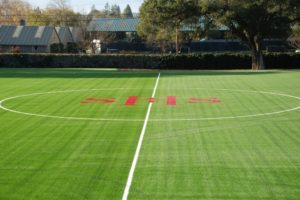In every market where there’s a major change, there’s a tipping point when consumers decide they no longer want to buy into what is currently being offered – even if those offerings have been around for some time. The turf infill industry may be ready for its own tipping point.
Greenplay and our founder, Domenic Carapella, were recently featured in an article on plant-based infill in the turf market for a publication called Athletic Business. If you haven’t had a chance to read the article yet, we would highly encourage you to check it out and see what the latest trend is in the synthetic turf market.
The trade magazine is a must-read for individuals in colleges and universities, high schools, park and recreation departments, military branches and bases, health clubs, YMCAs, professional sports teams, stadiums and arenas, sports architecture firms, and hospital and corporate wellness centers. Overall, there are 40,000 subscribers of the magazine as well as tens of thousands visitors to its online site.
Paul Steinbach wrote the piece, and he looked at the growing popularity of plant-based infill and why more readers of Athletic Business may be looking for alternatives to crumb rubber. The truth is that crumb rubber infill presents many issues. One infill supplier remarked how crumb rubber is hot, dusty, and smells. Plus, there have been some studies linking it to heat-related injuries and potential exposure to carcinogens.
Yet, crumb rubber is still used on a great majority of synthetic turf fields. Some estimate that it could be as much as 12,000 fields. Sure, crumb rubber is cheap, but there are way too many negatives to justify the number of synthetic fields that still have turf infill.
When Domenic Carapella was interviewed about plant-based turf infill, he was quick to point out that the market has grown exponentially in just three years. In the past 30 months, he said that Greenplay has supplied more than 60 fields. That’s significantly more than Carapella had supplied in the previous ten years. Carapella says the public wants alternatives and is driving the change towards natural infill.
Greenplay’s organic infill is made from sustainable plant-based materials that offer customers the best overall safety options. Greenplay’s turf infill features comparable field temperatures to grass, low Gmax ratings to reduce the threat of significant injury, enhanced foot stability, low abrasion, and more.
Although there is a long way to go before plant-based turf infill becomes the standard, the enthusiasm for alternatives to rubber crumb indicates we will eventually get there.
Public school districts, private schools and municipalities continue to choose to have synthetic turf installed; they need to make decisions on what products to utilize. There are different choices of infill available on the market today and going directly to the source with questions should be part of due diligence. Testing data and product specifications are important factors to determine the safest infill that best suits community need. Questions on maintenance should also be asked at the source to avoid misinformation.
Greenplay’s Corkonut® infill is a proven choice of infill that is presently installed in over 50 fields across the country. It has been tested and proven to lower surface temperatures to within 20 degrees of natural grass. Greenplay has also been tested for toxicology, performance, durability and abrasion with outstanding results. All testing data is available upon request.
Routine maintenance is required for all fields regardless of the choice of infill to ensure that the synthetic turf playing surface is free of debris or contaminants that can compromise the safety of the field as well as to raise the turf fibers with brushing to allow them to perform as designed.
Seasonal maintenance is also required for all fields regardless of the infill utilized. It is important that the surface of the infill be uniformly flat and even across the field. The height of the infill matters because too much free pile space can cause the turf fibers to lose support and become weakened. It may be necessary to add infill after some time to top off the field. With Greenplay, on average, about three percent of infill may need to be added per year. That’s it.
When ready for their new field, Sacred Heart Prep asked the right questions. “I was sent out on a mission to find a field that was safe and had great playability and something we could live with for the long term”. “One of our big concerns was about maintenance…we asked a lot of questions and liked the answers and what we found is that it’s actually better than we thought!” – Bret Simon, Athletic Director at Sacred Heart Schools, Atherton, CA on Greenplay®
